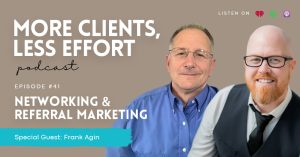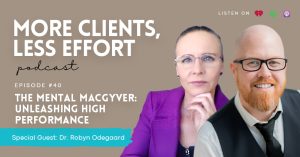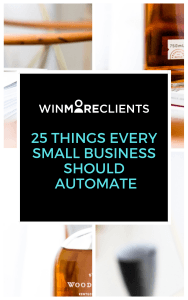Facebook has changed the world in so many ways. We now know exactly what our friend’s kids are doing at almost every moment in time and we can catch up on news and content which interests us from the one place.
Over the years, this platform has cleverly gotten to know our personal preferences. In doing so, it has become an incredibly helpful tool for marketers.
The beauty of Facebook advertising is you can target a specific audience and decide exactly which people you want to see your ads. From global youth-fashion retailers to the kebab shop on the corner, this means you’re able to get more out of every advertising dollar you spend. What’s more, getting started is easy and won’t break the bank.
However, just because Facebook makes it easy to advertise doesn’t mean your ads will be effective. There still needs to be a considerable amount of thought behind them.
Here are the factors you need to take into account in order to create Facebook ads that convert.
Audience
A clear understanding of your target audience is imperative when creating Facebook ads. Firstly, you need to ask if they use your platform and if they are likely to interact with ads for your brand.
For example, a family photographer may have great success marketing on Facebook to locally-based adults, aged between 25 – 45, who are known to be interested in children, pregnancy and parenting. If the business has a special deal to offer, the advertisement will likely be successful.
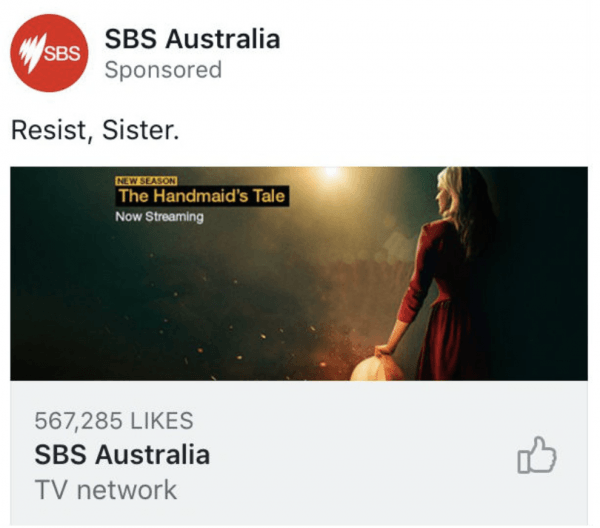
[SBS speaks directly to females with this ad promoting their page]
A company like a high-end marine insurer, on the other hand, may try targeting ads at excessively wealthy, super-yacht owning citizens of the world. I don’t know about you, but I get the feeling these types a) aren’t on Facebook and b) are likely to take a far more considered approach to selecting an insurer than clicking on a random ad.
I could be wrong about both these examples! This is why having a clear understanding of your target audience and their habits is important before kicking off a Facebook advertising campaign.
Placement
The next thing you must consider is where you want your Facebook ad to display and what type of template you will use.
There are over a dozen different ad options and templates to choose from, depending on how and where you want your ad to appear on Facebook.
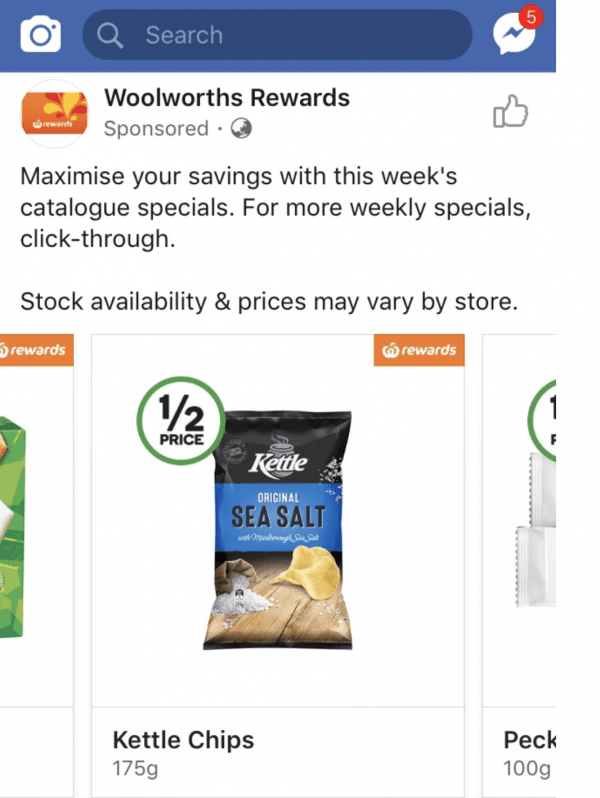
[Woolworths uses a carousel template to sell tempting snacks]
You also need to consider the purpose of your ad. Are you trying to grow page likes? Perhaps you want to direct users to a landing page or a blog post. Your decision will depend on elements like your budget, your target audience and your desired result. You may wish to stick with one ad format or trial a couple at a time to see what works best.
Headline
If you’re using an ad template which requires a headline under the image, make sure it packs a punch. According to Hubspot, the best-performing headline length is around four words so it is important to make them count.
Use compelling adjectives which pique people’s interest such as ‘jaw-dropping’, ‘cost-saving’, ‘groundbreaking’, ‘unprecedented’ and ‘unmissable’.
Here are some examples:
- 20% off for new customers
- The secret to beautiful skin
- The POWERFUL new method
- Unbeatable prices on new models
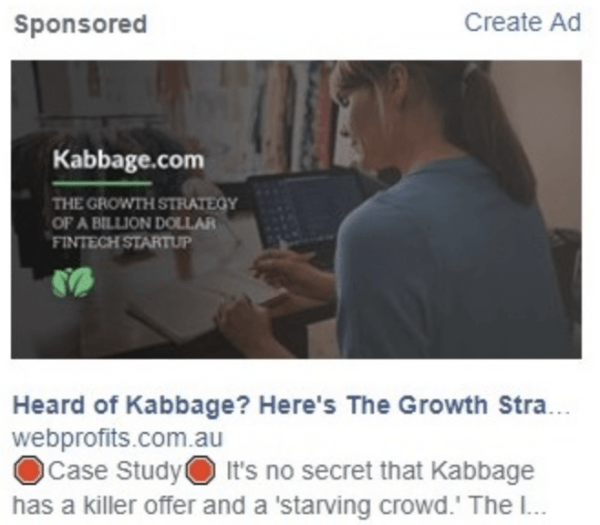
[I’m not so excited about this headline. It is cut off and doesn’t clearly share the benefits of the product]
Text
The text of your ad sits above the image. Generally speaking, my advice would be to keep it short.
If you decide to ‘go long’, make sure the copy is compelling enough to incite the user to click. Add a short headline underneath which clearly explains what you’re selling.
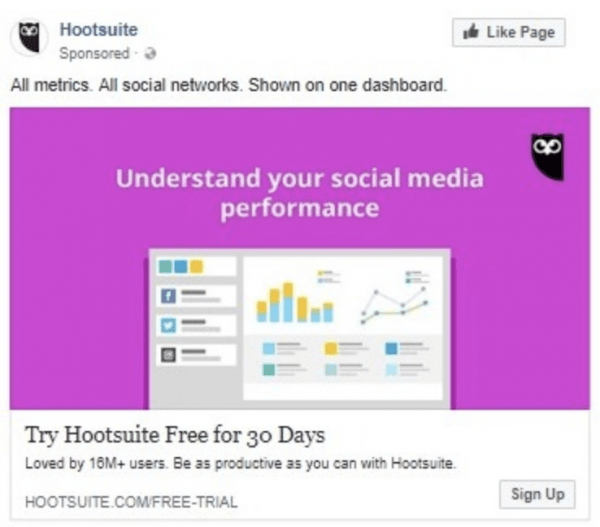
[Hootsuite keeps it very simple in its Facebook ads text, with short sentences and a clear description of its core purpose. It has a great headline underneath the image too].
Remember those users are scrolling fast. Refine your text so it sells the benefits and is not ambiguous. Talk directly to your audience and remember they are using Facebook as a way to mentally check out so don’t be afraid to be entertaining.
Description
The description section of your ad sits underneath the headline in an in-feed ad. This provides you with a secondary opportunity to get your audience to take the next step. Consider the words you can use to make this copy enticing, for example:
- Stocks are limited
- Offer ends June 30th
- Is this the day you change your life?
- The absolute best hotel you will ever experience
Caption/URL
This is where you link to your website and is another chance to share the name of your business. Add a clear, comprehensive URL which is strongly linked to your business.
It may work well to have a landing page URL, e.g. winmoreclients.com/learn-facebook, which gives your audience another prompt demonstrating exactly what they’ll be getting when they click.
Emojis
While many of us are spending upwards of an hour on Facebook per day, a lot of the scrolling we do is mindless. This is why using emojis can be a clever way to stand out, particularly if you can have some fun with them.
Some quick tips:
- Don’t use emojis which make no sense!
- Do be clever and witty
- Don’t cram in a zillion emojis
- Do use emojis to enhance your text rather than replacing it, unless you are a youth-focused brand and can get away with solely communicating with this method
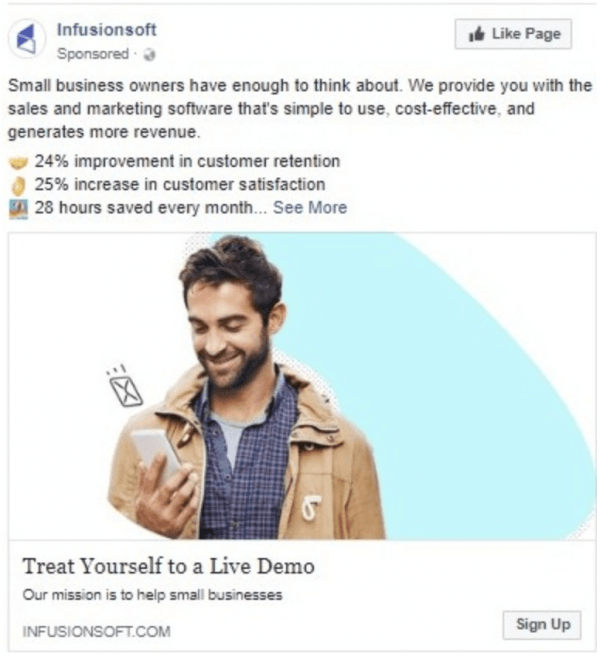
[Easy to interpret emojis work for this InfusionSoft ad]
CTA
What do you want your user to do? Read? Learn? Join? Subscribe?
Choose carefully for the best results and make sure the page they are directed to allows them to do what you have suggested. According to The Digerati, some CTAs work better than others – those used the most in top performing ads are ‘Learn More’, ‘Shop Now’ and ‘Sign Up’.
If you are using remarketing to serve ads to people who have previously been on your website, you may wish to consider a different set of calls to action, e.g. ‘Book Now’ as compared to ‘Learn More’
Image
I can’t say this enough: your image is so so so so so so so important.
Make use of your image to add some extra text by editing it with a tool like Canva. Use eye-catching graphics with colours that stand out and create graphics which are unique. One handy resource you can check out is www.unsplash.com, which offers high quality, royalty free images.
If you don’t have time to scroll through thousands of images, subscribe to Shutterstock or Getty, which allow you to add several search criteria to help you select the image you want. In general, clear images with only one or two subjects and happy, smiling faces looking directly at the camera are the ones to choose to get people to pause and click.
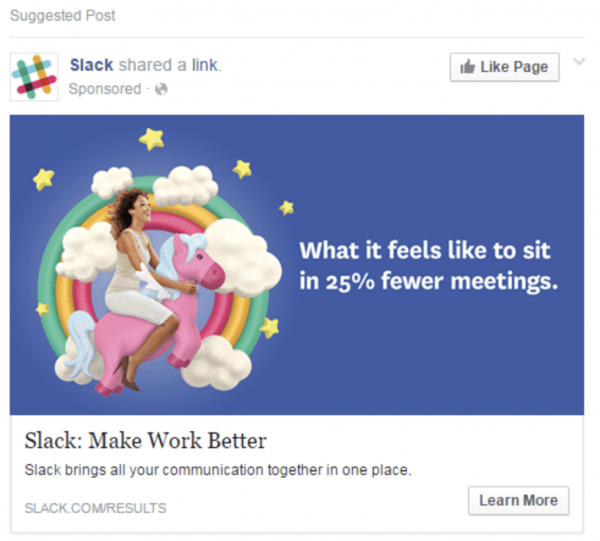
[This stand-out example was shared by WordStream. The picture is colourful, whimsical and the text boosts the clear headline and product description]
Video
If you have the budget, you can include video in your ads. Some brands are using gif-style tactics, creating videos which only last two or three seconds. Others use animation to convey their message to their audience.
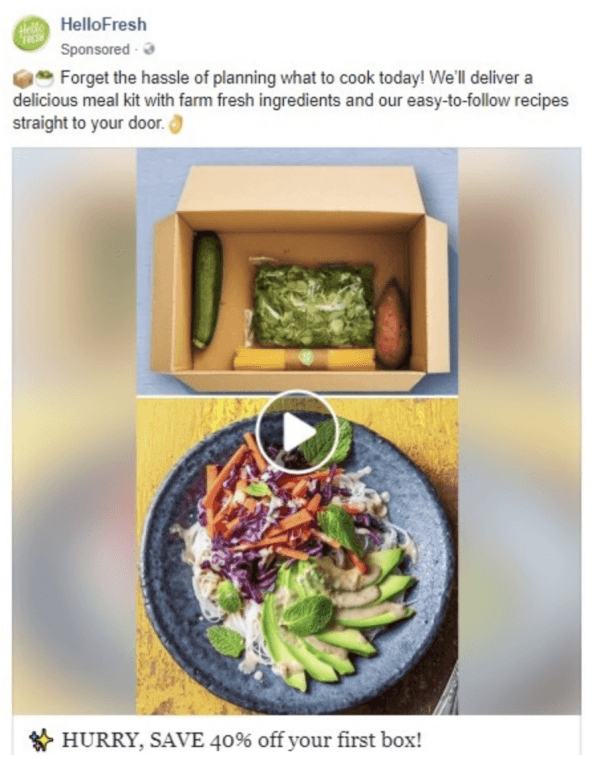
[Unless the user has turned off the functionality, these videos will automatically play in their feed. This HelloFresh example uses delicious looking foods in lots of appealing, bright colours]
One more point: 85 per cent of Facebook users watch videos with the sound off (probably because they should be working). To increase your results, make sure your ad makes sense without the audio or give users a darn good reason to switch it on.
Test, measure and refine
Once you have created your ads, check that they look ok across devices. Images which aren’t the right size or clever headlines which are cut off won’t bring you the results you’re looking for. Have a look on desktop, mobile and tablet and tweak your ads to make sure they’re looking their best.
One of the main benefits of Facebook advertising is how easily you can see your results. Make the most of this feature by creating a couple of different ads and reviewing the way they perform.
You may find one image is far more powerful than another. If this is the case, you know what to focus on. Alternatively, one headline, description or call to action may work better for your brand. Kill the ad which is performing less and see what else you can come up with to appeal to your audience.
The top tier Facebook marketers are constantly testing, measuring and refining the ads they run to get the best return on investment for their advertising dollars.
One final point: If you’re advertising on Facebook, allocating $10 per day and not getting any clicks, it may not be the ad design’s fault. It could be that you need to put a more substantial budget towards getting results.
For guidance on how to create stand-out Facebook ads and how to get people to click, contact Win More Clients.
Related Tag: Sales Automation Consultant

